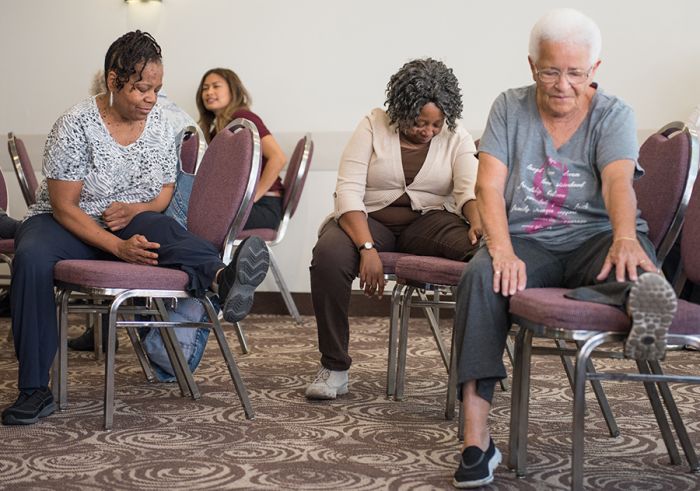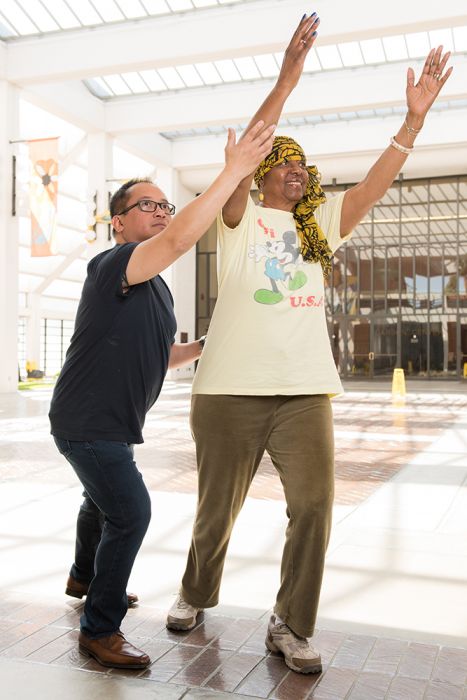
On a Thursday morning last spring, Paul Penoliar and his CSUDH student assistant, Isabelle Guevera, help 15 older adults do a series of stretching exercises.
Stretching will give you a better quality of movement,” the longtime occupational therapist and CSUDH lecturer tells them. “It helps you to become more flexible. Stretching helps joint issues and provides stress relief.”
Some of the seniors have back pain, others are recovering from breaking bones and from surgery; Penoliar shows them how they can adapt the exercises to accommodate their abilities.
It’s no secret that one of the most pressing health care concerns in the United States is the increasing demand for innovative, cost-effective community-based programs to address the needs of the burgeoning population of adults aged 50 and older.
A recent report jointly produced by the Centers for Disease Control and Prevention, AARP, and the American Medical Association states that seniors–particularly racial and ethnic minorities–do not receive the preventive services they need to stay healthy.
In fact, according to the report, seniors often are unaware of the clinical preventive services recommended for their age, gender, and risk factors, and do not receive systematic referrals for treatment.
Clinicians and public health practitioners agree that community-based programs must provide more and better affordable, preventive care to vulnerable seniors.
With that in mind, Cal State Dominguez Hills professors in the Department of Occupational Therapy have developed Community-HELP (Community-based Health Enhancement Lifestyle Program) and have teamed up with the City of Carson to study its effectiveness on seniors at the Carson Community Center, just a few minutes’ drive from the Dominguez Hills campus.
Data is collected from participants before and after the program to assess areas of lifestyle improvement. Community-HELP also serves as a clinical service-learning experience for students in CSUDH’s Master of Science in Occupational Therapy program.
“This effort is part of our department’s vision and our program’s mission to serve the community,” says Associate Professor Terry Peralta-Catipon, department chair and the project’s principal investigator. “It has been quite successful serving people literally in our backyard as a collaborative research project.”
Community-HELP is an interdisciplinary collaboration that addresses the broad spectrum of senior health issues as perceived by occupational and physical therapists, nurses, kinesiology specialists, and social workers. The program offers seniors readily accessible lifestyle exercises, strategies, and support to improve their overall wellness and wellbeing.
The program is largely based on Associate Professor Eric Hwang’s research in geriatric occupational therapy. That research led him to create the Health Enhancement Lifestyle Profile, a series of assessment tools that includes an in-depth health and lifestyle survey, a shorter questionnaire, and a clinician’s guide that score the answers and provide metrics to help clinicians devise a plan specifically for their clients that promotes more healthful practices based on their needs.
Hwang became interested in how seniors live healthy lives after observing his wife’s 93-year-old Taiwanese grandfather, who hadn’t seen a medical doctor in nearly 30 years.
“I stayed with him for a couple of days and observed his lifestyle,” Hwang recalls of his visit to Taiwan. “It was healthy and natural, the way our lives should be.” The old man rose at 5 or 6 o’clock in the morning and practiced tai chi, then went to the vegetable garden and did some physical work. He ate a Japanese macrobiotic diet.

The example prompted Hwang to think deeply about healthy senior lifestyles.
“It inspired me to create something to encourage people to look deep into their lifestyle,” says Hwang.
“Most people deep inside know how unhealthy their lifestyle is, so we bring that awareness to a conscious level,” he adds. “And it’s not just about exercise and diet, but stress management, social participation, and emotional health.”
After assessing each client at the Carson Community Center using Hwang’s HELP survey, Penoliar tailors a plan that reinforces their individual needs and sets future fitness goals, such as increasing the time of outdoor walks or pace on a treadmill.
“We help our clients realize how they can fit exercise and fitness into their schedules,” Penoliar says, noting that sedentary seniors often are inspired to change their routines to become more physically active and mentally engaged. “They are so supportive of each other.”
The program’s holistic approach centers on the individual’s personal life, occupation, environment, motivations and interests, Penoliar says. “We look at body symptoms, pain and fatigue, their personal habits and routines, which affect their successful engagement. What are their social support networks?
“We can determine community resources that can help, such as transportation, and we can show them how to perform activities using adaptive techniques,” he notes. “We discover the values and interests of our clients and the things they desire to do. When they can perform these things again, their self-esteem improves along with their health.”
Community-HELP participant Gloria Young of Los Angeles recalls that she noticed signs advertising the program recently when she dropped her grandson off at the Carson Community Center. “I’m so happy I took a moment to stop by to see what was going on,” Young says. “I need this so much. I procrastinated so much. This class has helped me to reach some very important health goals.”
Fellow participant Jane Galazo of Carson says the class helps her manage a host of physical ailments, including high blood pressure, heart issues, high cholesterol, osteoarthriti,s and osteopenia.
“I want to share this with my husband,” Galazo says. “He can’t stay away from the computer so he has issues with joints and muscles.”
Written by Cathi Douglas. This story first appeared in the Summer 2016 issue of the university magazine, Dominguez Today.